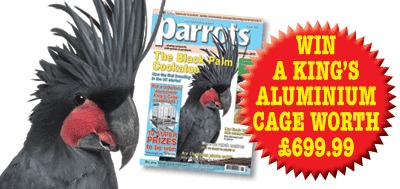
Buy your copy now!
Save money if you subscribe - 12 issues for the price of 11
In this issue...
- What to do about the rescue and adoption dilemma? - read more
- Finding parrot friendly coffee - read more
- A perfect choice for learning the basics - read more
- The magnificent and mighty Black Palm Cockatoo - read more
- News 2010 from the Loro Parque Fundación - read more
- News, Bird Alert, Readers Story, FREE classified advertising and a full listing of Avian Vets
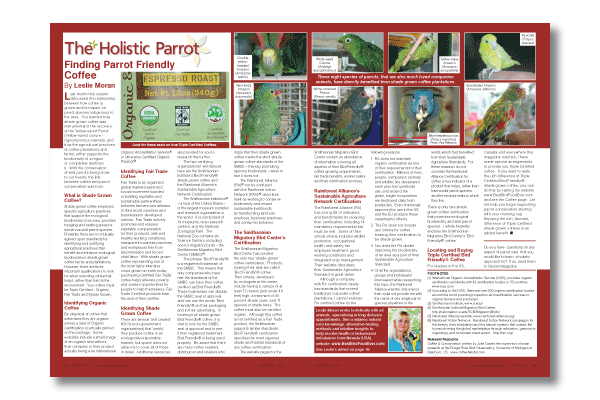
Finding Parrot Friendly Coffee
Last month this column discussed the relationship between how coffee is grown and its impact on parrot species indigenous to the area. You learned how shade grown coffee was instrumental in the recovery of the Yellow-eared Parrot (Yellow-eared conure - Ognorhynchus icterotis), and how the agricultural practices of coffee plantations and farms, either supports the biodiversity of a region or completely destroys it. With the conservation of wild parrots being close to our hearts, the link between coffee and parrot conservation was born.
What is Shade Grown Coffee?
Shade grown coffee employes specific agriculture practices that support the ecological biodiversity of an area, provides foraging and nesting areas for numerous wild parrot species. Presently there are no mutually agreed upon standards for identifying and certifying agricultural practices that benefit and enhance ecological biodiversity in shade grown coffee farms and plantations. However, there are three important qualifications to look for when selecting coffee that helps, rather than harms the environment. Your coffee must be Triple Certified - Organic, Fair Trade and Shade Grown.
Read more in the magazine…
Buy a copy now!
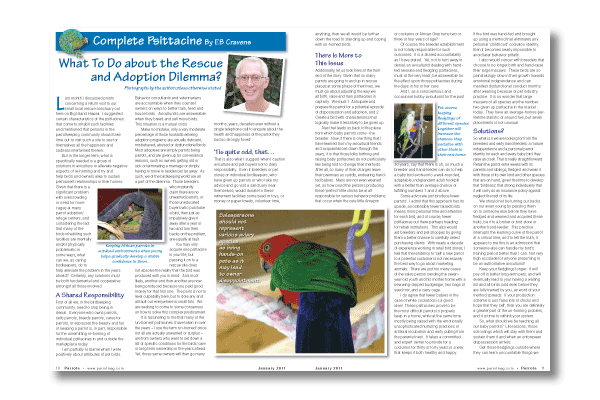
What To Do about the Rescue and Adoption Dilemma?
Last month I discussed points concerning a return visit to our small local rescue sanctuary out here on Big Island Hawaii. I suggested certain characteristics of the psittacines that come to inhabit such facilities and mentioned that persons in the parrotkeeping community should take time out to visit such a site to see for themselves all the happiness and sadness intertwined therein.
But in the longer term, what is specifically needed is a group of solutions in aviculture to alleviate negative aspects of re-homing and try and help birds and owners alike to sustain permanent relationships in their homes. Given that there is a significant problem with overcrowding or need for more cages at many parrot adoption/refuge centers, and considering the fact that many of the birds inhabiting such facilities are mentally and/or physically problematic in some ways, what can we, as caring birdkeepers, do to help alleviate the problem in the years ahead? Certainly, any solutions must be both fundamental and cooperative amongst all those involved.
Read more in the magazine…
Buy a copy now!
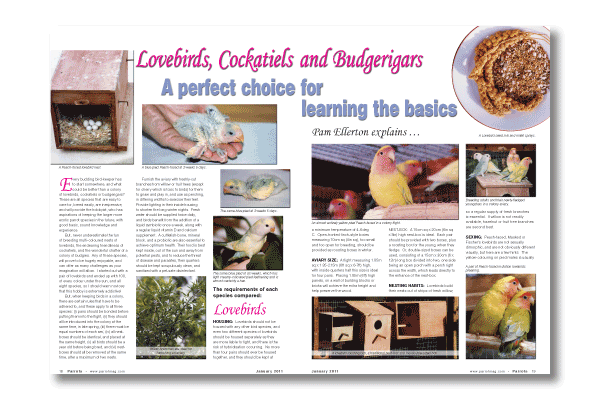
Lovebirds, Cockatiels and Budgerigars - a perfect choice for learning the basics
Pam Ellerton explains
Every budding bird-keeper has to start somewhere, and what could be better than a colony of lovebirds, cockatiels or budgerigars? These are all species that are easy to care for, breed easily, are inexpensive, and will provide the hobbyist, who has aspirations of keeping the larger more exotic parrot species in the future, with good basic, sound knowledge and experience.
But, never underestimate the fun of breeding multi-coloured nests of lovebirds, the endearing friendliness of cockatiels, and the wonderful chatter of a colony of budgies. Any of these species, will prove to be hugely enjoyable, and can offer as many challenges as your imagination will allow. I started out with a pair of lovebirds and ended up with 100, of every colour under the sun, and all eight species, so I should warn novices that this hobby is extremely addictive!
But, when keeping birds in a colony, there are certain rules that have to be adhered to, and these apply to all three species: (i) pairs should be bonded before putting them into the flight, (ii) they should all be introduced into the colony at the same time, in late spring, (iii) there must be equal numbers of each sex, (iv) all nest-boxes should be identical, and placed at the same height, (v) all birds should be a year old before being bred, and (vi) nest-boxes should all be removed at the same time, after a maximum of two nests.
Read more in the magazine…
Buy a copy now!
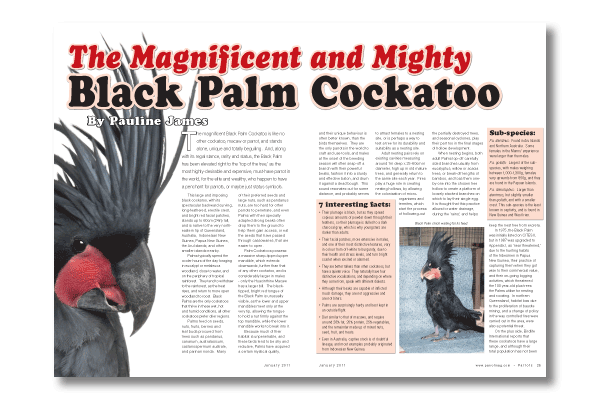
By Pauline James
The magnificent Black Palm Cockatoo is like no other cockatoo, macaw or parrot, and stands alone, unique and totally beguiling. And, along with its regal stance, rarity and status, the Black Palm has been elevated right to the ‘top of the tree,’ as the most highly-desirable and expensive, must-have parrot in the world, for the elite and wealthy, who happen to have a penchant for parrots, or maybe just status symbols.
This large and imposing black cockatoo, with its spectacular backward curving, long-feathered, erectile crest, and bright red facial patches, stands up to 60cm (24in) tall, and is native to the very north-eastern tip of Queensland, Australia, Indonesian New Guinea, Papua New Guinea, the Aru Islands, and other smaller islands nearby.
Palms typically spend the cooler hours of the day foraging in eucalypt or melaleuca woodland, close to water, and on the periphery of tropical rainforest. They tend to withdraw to the rainforest, as the heat rises, and return to more open woodland to roost. Black Palms are the only cockatoos that thrive in these wet, hot and humid conditions, all other cockatoos prefer drier regions.
Read more in the magazine…
Buy a copy now!
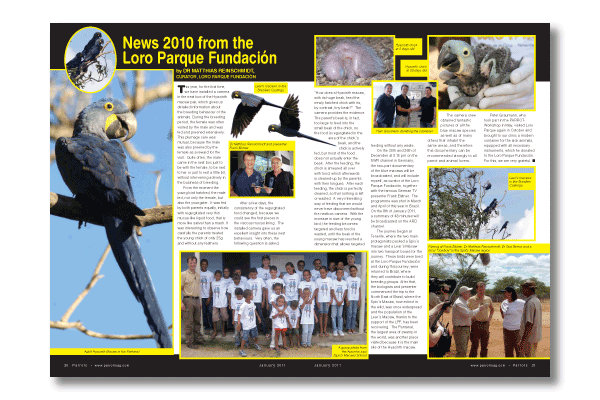
By Dr Matthias Reinschmidt
This year, for the first time, we have installed a camera in the nest box of the Hyacinth macaw pair, which gives us detailed information about the breeding behaviour of the animals. During the breeding period, the female was often visited by the male and was fed and preened extensively. This plumage care was mutual, because the male was also preened by the female as a reward for the visit. Quite often, the male came in the nest box just to be with the female, to be next to her or just to rest a little bit, without intervening actively in the business of breeding.
From the moment the young bird hatched, the male fed, not only the female, but also the youngster. It was fed by both parents equally, initially with regurgitated very thin mucus-like liquid food, that is more like saliva than a mash. It was interesting to observe how carefully the parents treated the young chick of only 25g and without any feathers.
Read more in the magazine…
Buy a copy now!






